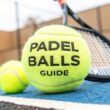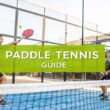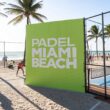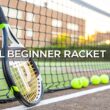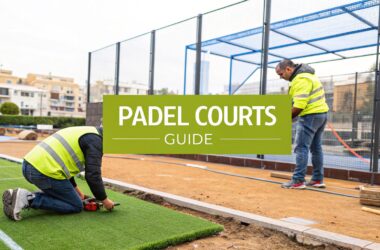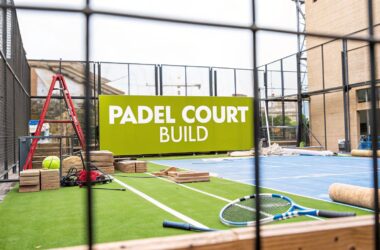So, you're wondering how much it costs to build a padel court. The short answer? It's typically somewhere between $25,000 and $50,000. This ballpark figure covers the essentials: groundwork, the enclosure, turf, and lighting.
A simple court for your backyard will land on the lower end of that spectrum. But if you're aiming for a premium, club-quality setup, you can expect to sail past that higher number.
Your Padel Court Cost Quick Answer Guide
Think of building a padel court like building a custom car—the final price tag really comes down to the parts you pick. A basic, no-frills setup gets you on the court and playing. But when you start upgrading to premium glass walls, tournament-grade turf, and professional lighting, you elevate the entire experience… and the budget. Getting a handle on this from the get-go is the key to planning a realistic project.
That initial estimate gives you a solid financial starting point. Looking internationally, the cost to get a standard outdoor padel court up and running usually falls between €18,000 and €40,000 (which is about $20,000 to $43,000 USD). A huge factor in that price is the enclosure. You can go with a more budget-friendly metal mesh, or you can opt for the premium tempered glass that high-end clubs love for its clean, professional look. You can find more insights on international padel court costs on afpcourts.com.
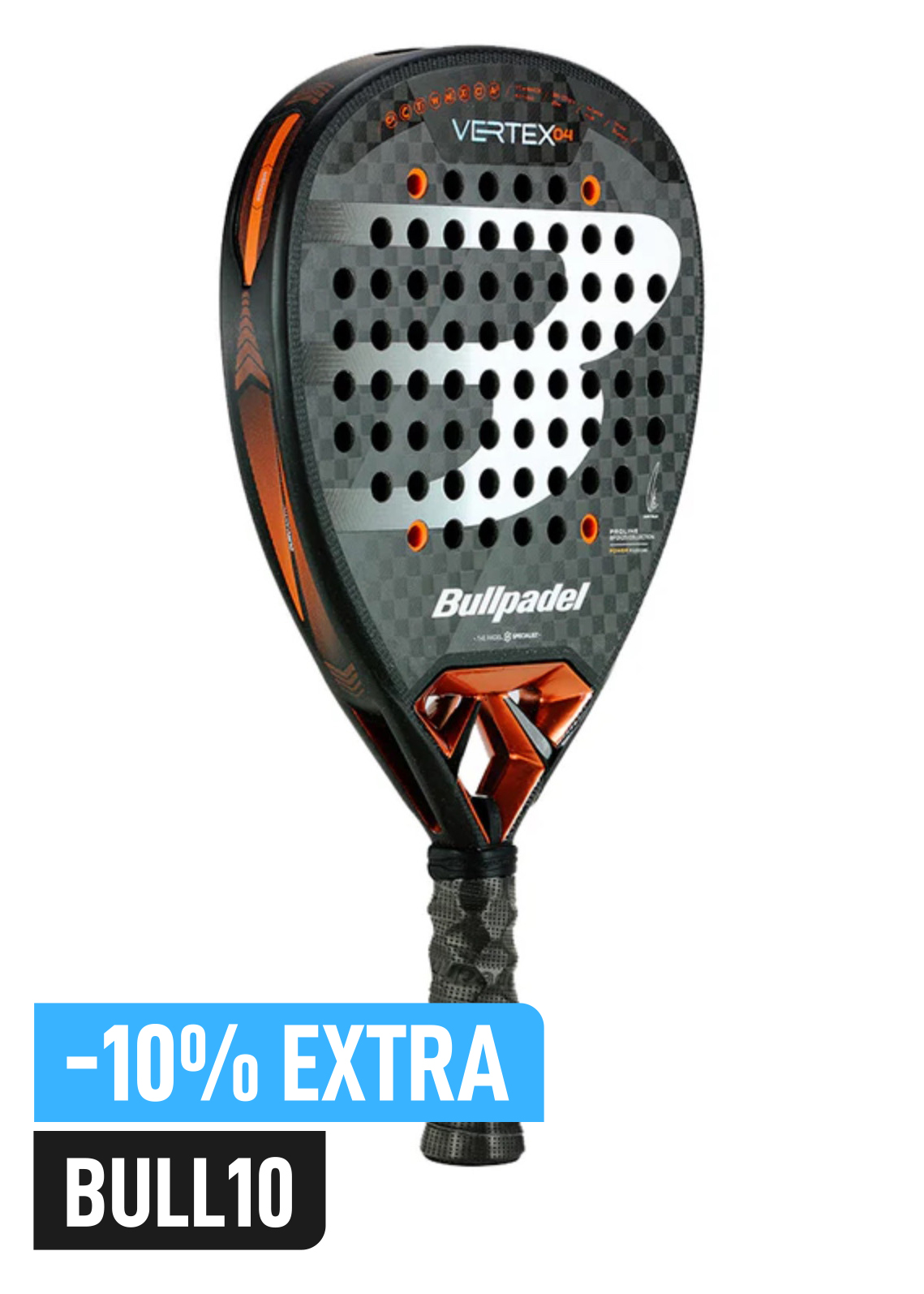
Buy the best padel gear to level up your next game!
CHECK OUT this deal from Padel Market!Get ready to take your game to the next level with the latest padel gear from Padel Market! Fast EU and Worldwide Shipping
To give you a better idea of where your money actually goes, let's look at a typical budget breakdown. This pie chart shows how the costs for a standard court build are usually split.
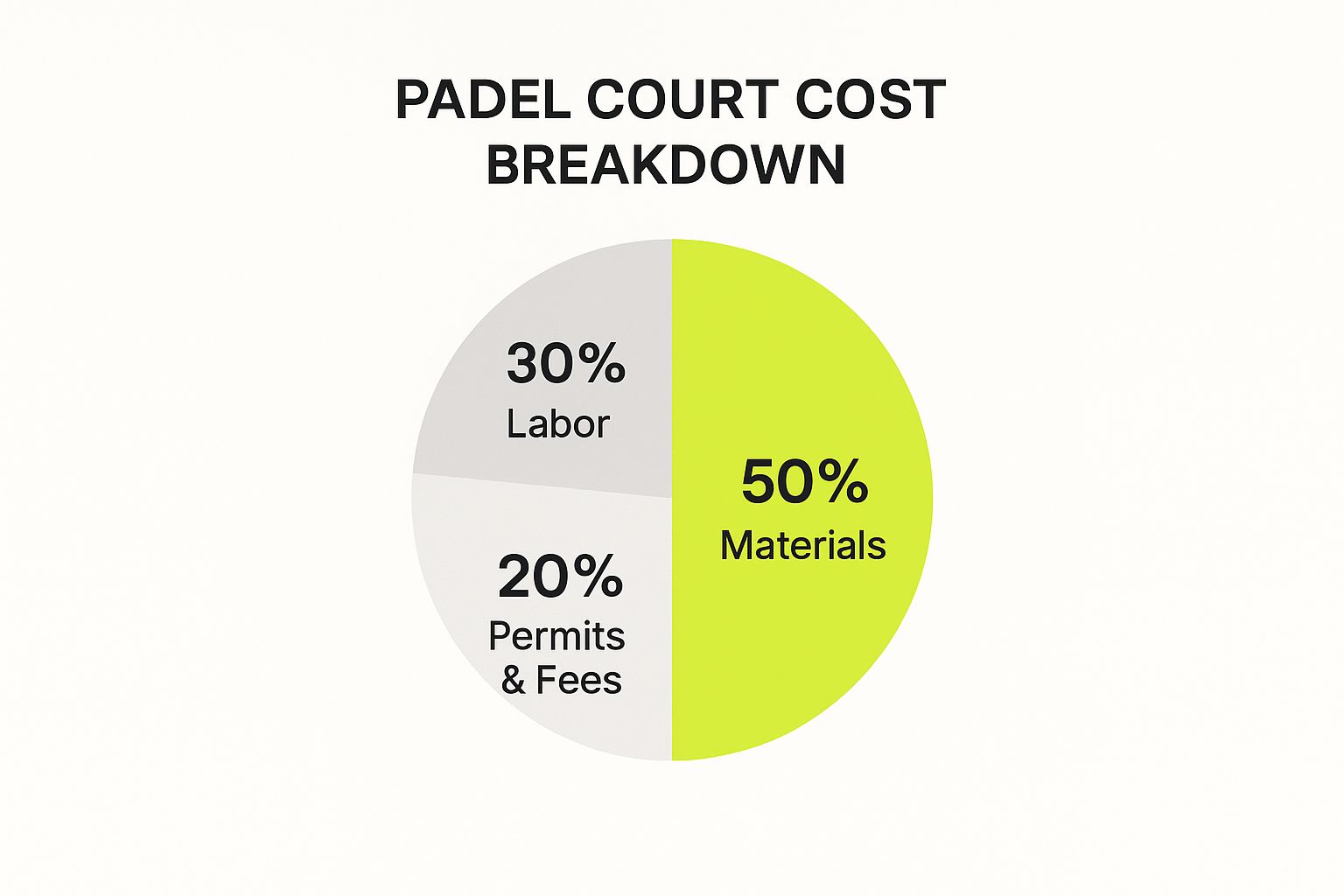
As you can see, materials make up a whopping half of the total cost. This means your choices in turf, glass, and the steel structure will be the biggest factors driving your final price.
Estimated Padel Court Cost Breakdown
To zoom in a bit closer, the table below breaks down the estimated costs for each major component. This will give you a much clearer picture of the typical price ranges you can expect for everything involved in a standard court installation.
| Component | Low-End Cost Estimate (USD) | High-End Cost Estimate (USD) | Key Factors |
|---|---|---|---|
| Foundation & Groundwork | $4,000 | $8,000+ | Soil quality, site accessibility, concrete vs. asphalt base. |
| Steel Structure & Fencing | $8,000 | $15,000+ | Thickness of steel, galvanization quality, mesh vs. panoramic glass. |
| Glass Walls (Tempered) | $6,000 | $12,000+ | Glass thickness (10mm vs. 12mm), panoramic design. |
| Artificial Turf Surface | $4,000 | $7,000+ | Monofilament vs. fibrillated turf, sand infill quality. |
| Lighting System (LED) | $2,000 | $6,000+ | Number of poles (4 vs. 8), lumen output, brand quality. |
| Labor & Installation | $5,000 | $10,000+ | Regional labor rates, crew experience, project complexity. |
Use this table as a starting point to map out your own project budget. It helps to see how decisions in one area, like choosing panoramic glass, can impact the overall cost.
Building from the Ground Up: Foundation Costs
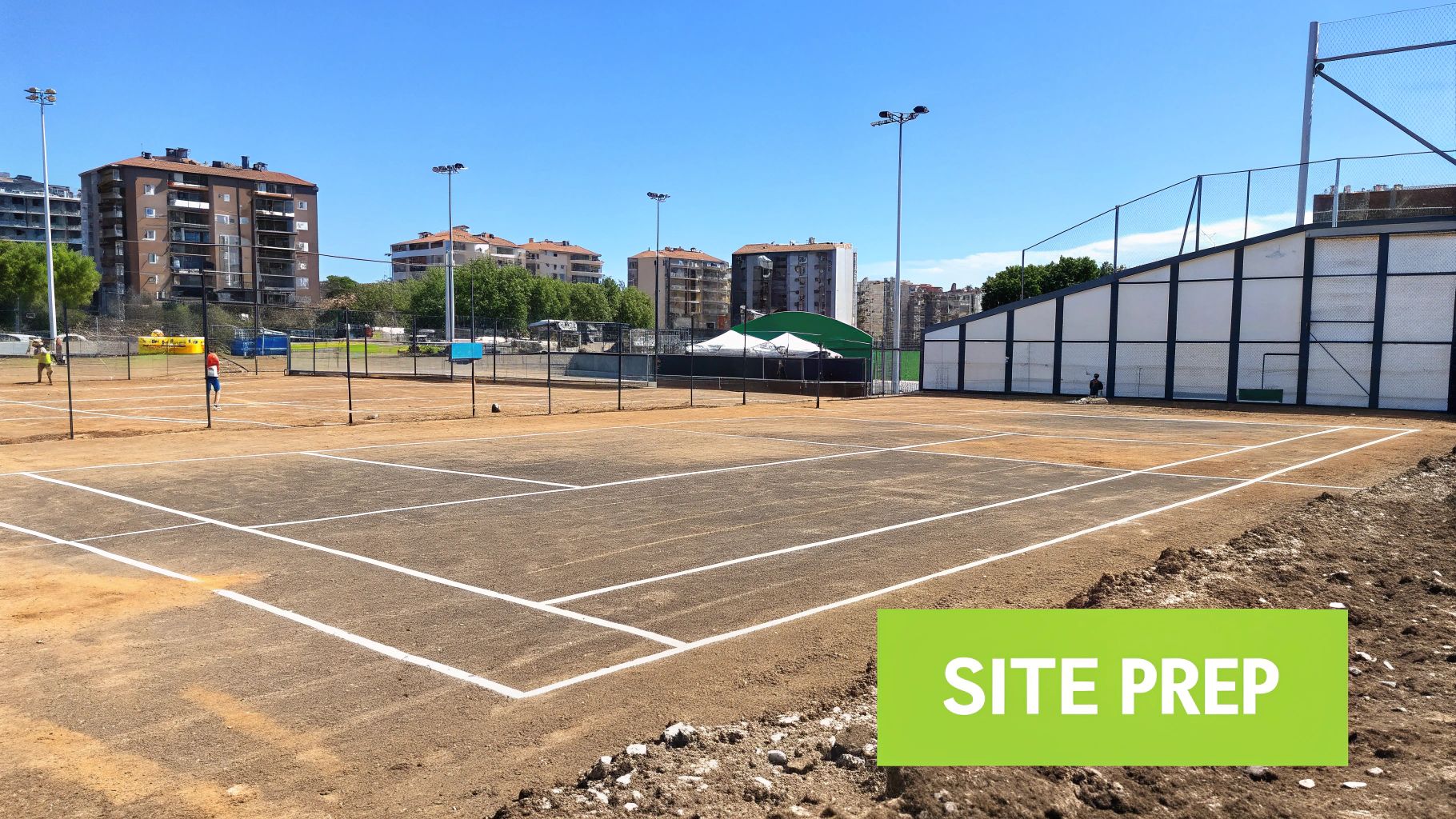
Any world-class padel court is only as good as what’s underneath it. Think of the foundation as the unsung hero—it’s the critical component that dictates your court’s longevity, how the ball plays, and even safety. Skimping here is like building a beautiful house on quicksand. It's just a recipe for disaster.
This groundwork is hands down one of the biggest variables in your total budget. A perfectly flat, ready-to-go site might only need minor leveling. But a sloped or rocky piece of land? That can easily add thousands to your bill before you even think about concrete. The investment you make in proper site prep now will save you a fortune in repairs down the road.
And this isn't just a local trend. The global demand for quality padel courts is absolutely surging. The market was valued at a massive $3.81 billion USD in 2023 and is projected to explode to $12.51 billion by 2031. This crazy growth just highlights how important it is to get every step right, especially the foundation.
The Crucial First Steps: Site Preparation
Before a single shovel hits the dirt, a thorough site assessment is non-negotiable. This is where you spot the potential problems that could derail your project or blow up your budget later on.
The process usually breaks down into a few key stages:
- Soil Testing: A geotechnical engineer will analyze the soil to figure out its stability and what it's made of. This is crucial for knowing if the ground can actually support a heavy concrete slab without shifting or cracking.
- Excavation and Grading: Next, the crew clears out all the vegetation, rocks, and debris. They’ll dig down to the right depth and grade the land to create a perfectly level and stable base for the court.
- Drainage Systems: You have to get the water away from the court. Proper drainage stops water from pooling underneath, which can lead to surface damage, mold, and even structural failure. This might mean installing French drains or creating a very subtle slope.
A classic mistake is seeing a "flat" piece of land and assuming it's good to go. Even tiny, invisible slopes can create huge water problems. Professional grading isn't a luxury; it's a must-have for a court that lasts.
Concrete Slab Versus Compacted Base
Once the site is prepped, you hit your first big decision: what kind of base will your court sit on? The two main options are a reinforced concrete slab or a compacted aggregate base, and they have a huge impact on both cost and quality.
A compacted base, which is usually made of crushed stone, is definitely the cheaper option. It can work for a temporary setup or a low-traffic residential court, but it's much more likely to shift and settle over time, leaving you with an uneven playing surface.
On the other hand, a reinforced concrete slab is the gold standard for any high-quality, permanent padel court. This involves pouring a thick slab of concrete—typically 10-15 cm (4-6 inches)—that's reinforced with a steel mesh (rebar) to stop it from cracking. While it costs more upfront, often running from $4,000 to $8,000, it guarantees a perfectly flat, incredibly durable surface that will last for decades.
Choosing a concrete slab is really an investment in your court's future. It provides the perfect foundation for the turf, ensures a true and consistent ball bounce, and protects the whole structure from shifting ground and bad weather. For a deeper dive into the construction details, our guide on padel tennis court construction has a lot more valuable info.

Buy the best padel gear to level up your next game!
CHECK OUT this deal from Padel Market!Get ready to take your game to the next level with the latest padel gear from Padel Market! Fast EU and Worldwide Shipping
Breaking Down the Core Components: Walls, Turf, and Lighting
Once your foundation is solid, it's time to build the parts of the court you'll actually see and play on every day. These core components—the walls, the turf, and the lighting—aren't just functional necessities; they define the entire playing experience and make up a massive slice of your budget.
Think of it like building a car. You've got the chassis (the foundation), and now you're choosing the engine, tires, and headlights. Each part has different performance levels and, of course, different price tags. You can go for a reliable, standard setup or invest in high-performance upgrades that seriously elevate gameplay, safety, and the long-term value of your court.
Let's dive into each of these three crucial pieces to see how your decisions will shape both your upfront investment and your ongoing costs.
The Enclosure: Walls and Fencing
The iconic glass and mesh enclosure is a padel court's most defining feature, and the materials you pick here are a huge cost driver. The whole structure needs to be tough enough to handle players crashing into it and balls smacking against it at high speed. The choice between steel mesh and tempered glass also completely changes the court's look and feel.
- Standard Steel Mesh: This is your budget-friendly starting point. It's a durable, no-frills option that gets the job done, making it a popular choice for backyard courts or clubs trying to keep costs down.
- Tempered Glass Walls: This is the premium choice, hands down. It offers amazing visibility for anyone watching and gives players that professional feel. The glass is typically 10mm to 12mm thick, ensuring consistent ball rebounds and creating that sleek, modern look you see in the big tournaments.
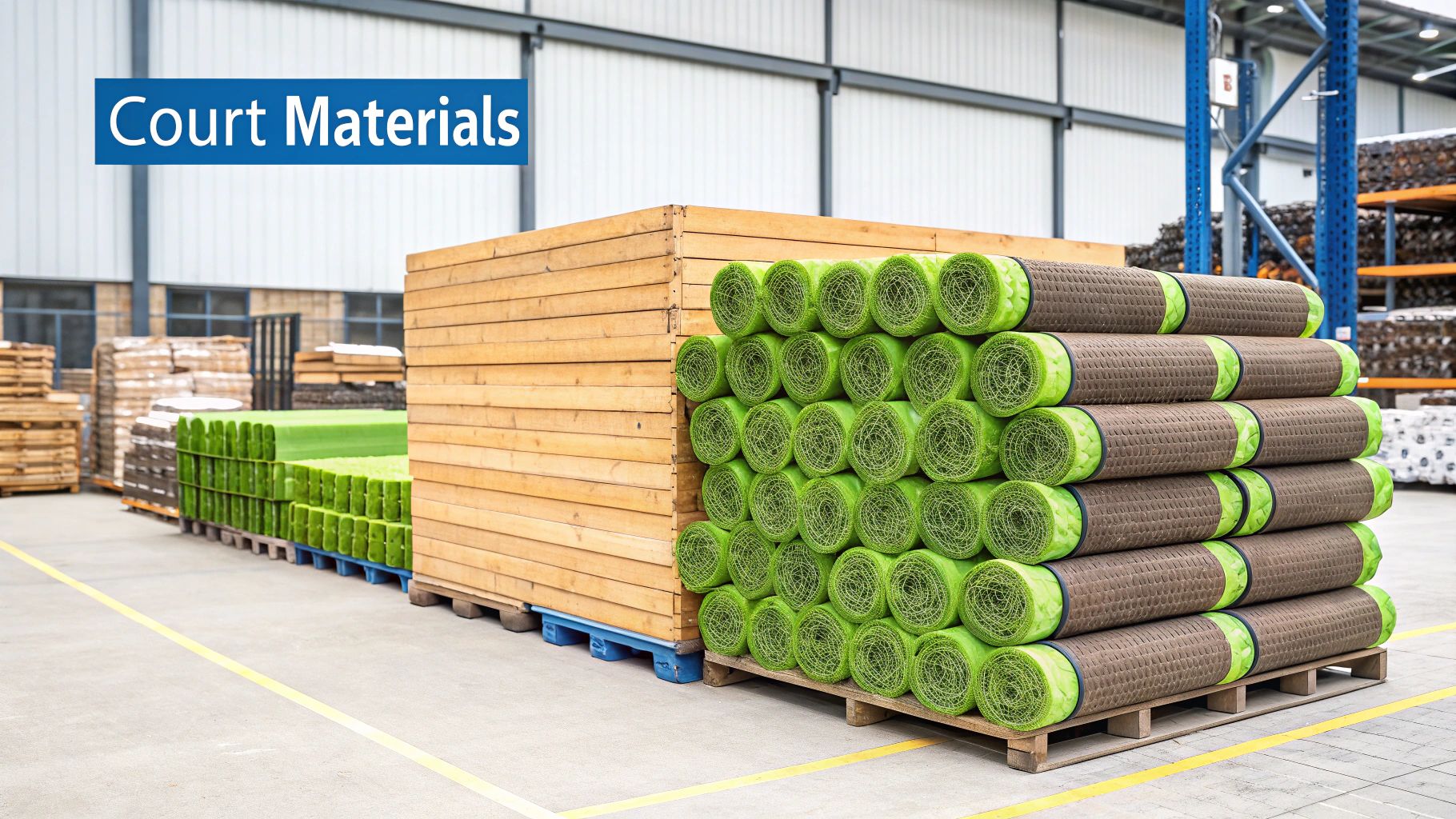
While steel mesh might save you some cash initially, panoramic glass courts are quickly becoming the industry standard. They don't just look better; they can often justify higher rental fees at a club, which means a faster return on your investment.
The decision between mesh and glass is a classic "cost vs. experience" dilemma. Mesh is practical, but a panoramic glass court transforms the space from a simple sports facility into a premium destination that players and spectators will love.
The Playing Surface: Artificial Turf
The ground beneath your feet is where all the action happens. The artificial turf on a padel court isn't just some green carpet—it's a specialized surface engineered for the perfect ball bounce, player grip, and safety. The type of turf you go with will directly impact how the game is played.
There are two main types of artificial grass you'll see on padel courts:
- Fibrillated Turf: This type has fibers that are split, creating a sort of net-like pattern. It's known for being incredibly durable and does a fantastic job of holding the silica sand infill, which adds stability and controls the game's speed.
- Monofilament Turf: This is the more modern, higher-end option. Each fiber is a single, distinct strand, giving the surface a look and feel that's much closer to natural grass. It usually provides a more consistent—and faster—ball bounce.
The turf itself is a pretty hefty investment. To get a really good handle on all the factors involved, it's worth exploring the real cost of artificial turf. Remember, this isn't just a one-time cost; artificial turf needs to be replaced every 5–8 years, depending on how much action it sees.
The Lighting System
Good lighting is a game-changer. It extends your playing hours, turning your court into a facility that can be used day or night, and it's absolutely essential for safety. A poorly lit court isn't just annoying to play on; it's a hazard. The choice usually boils down to old-school halogen lights versus modern LED systems.
Halogen lights might seem cheaper at first, but they come with some serious downsides. They burn through way more energy, don't last nearly as long, and often create harsh, uneven light.
LED lighting, on the other hand, is the clear winner for any new court. Yes, the upfront cost is higher, but the long-term benefits are impossible to ignore:
- Energy Efficiency: LEDs use up to 75% less energy than halogens. That translates to huge savings on your electricity bill over time.
- Longevity: They can last an incredible 25 times longer, which means you'll spend way less time and money on maintenance and replacements.
- Superior Light Quality: LEDs provide bright, even, glare-free light that feels a lot like natural daylight, which is way better for visibility and player comfort.
Investing in a quality LED system, usually with four to eight poles, ensures your court is properly lit for either fun matches or serious competition. To learn more about the exact playing area these components enclose, check out our guide on the official padel court size.
Digging Into the Hidden Costs of Construction
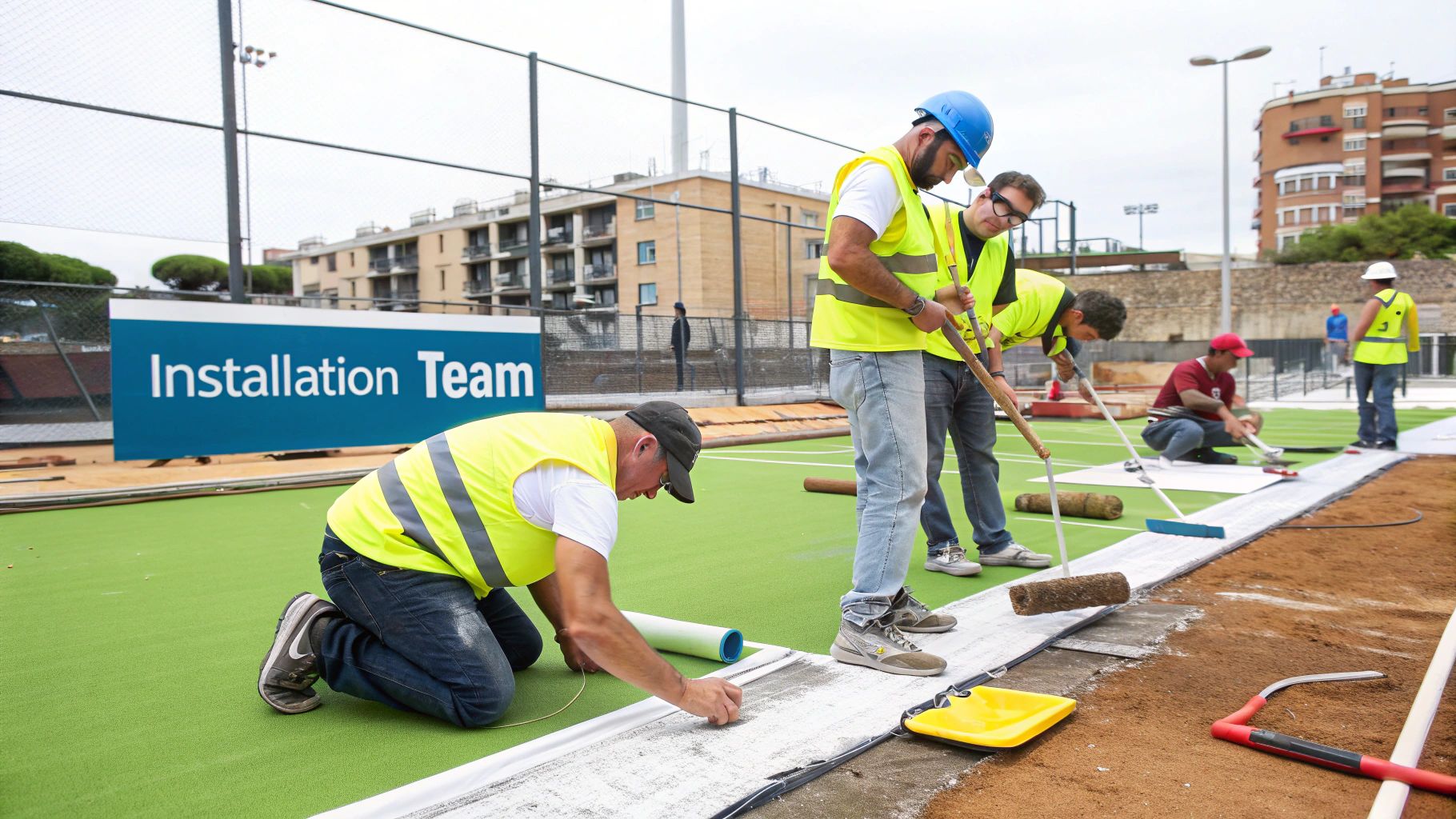
If you only budget for steel, glass, and turf, you're in for a rude awakening. The final price tag for a padel court is almost always higher than the initial quote because of a handful of "hidden" costs that can catch new owners completely off guard.
Think of it like buying a car. The sticker price is just the starting line. You still have to factor in taxes, insurance, and dealership fees. In the same way, your court budget has to cover everything from the crew swinging the hammers to the piece of paper from the city that says you're allowed to build in the first place.
The True Price of a Professional Crew
Labor is one of the biggest variables you'll face, easily eating up 20-30% of your total project budget. This isn't just one team doing everything; a quality installation requires a coordinated dance between several specialized crews, each with their own price point.
You’re really hiring a small army of specialists:
- Groundwork Crew: These are the folks who handle the heavy lifting—excavation, grading, and pouring the concrete foundation. Their work is tough and absolutely critical to getting everything else right.
- Structural Installers: This team puts up the steel frame and fencing. It’s all about precision here; if their measurements are off, the whole court is compromised.
- Glazing Specialists: Installing those massive 12mm tempered glass panels is no joke. It's a delicate, dangerous job that requires special equipment and a crew that knows exactly what they're doing.
- Finishing Technicians: The final touches, like laying the turf and wiring the lights, are handled by their own skilled pros.
Labor rates can swing wildly depending on where you live. A crew in a major city will cost a lot more than one in a rural town. Do your homework—get multiple quotes and make sure every single contractor is licensed and insured.
Navigating Permits and Zoning Laws
Before a single shovel hits the dirt, you have to deal with your local government. Building permits and zoning compliance are non-negotiable legal hurdles that add both time and money to your project. Trying to skip this step is a recipe for disaster, potentially leading to massive fines or even a demolition order.
The budget considerations for a padel court often mirror other major property additions, where you have to account for permits, materials, and unexpected fees. To get a sense of how these costs break down for other structures, this guide on the cost to build an ADU offers a useful comparison.
Be prepared for the permitting process to take anywhere from a few weeks to several months. That unpredictable timeline is a hidden cost in itself, capable of delaying your entire construction schedule.
Other Overlooked Project Expenses
Beyond the big-ticket items, a few other costs tend to slip through the cracks in early estimates. They might seem small individually, but they add up fast.
Make sure your budget has room for these:
- Shipping and Freight: That steel frame, those giant rolls of turf, and the heavy glass panels don't just magically appear. Depending on where your supplier is, freight can tack on another $1,000 to $3,000+ to the final bill.
- Site Accessibility: Can a concrete truck or crane actually get to where you want the court? If your site is hard to reach, you could be on the hook for extra costs for smaller vehicles, more manual labor, or even building a temporary access road.
- Essential Amenities: The court itself isn't the full experience. You'll need player benches, some shaded areas for hot days, walkways, and even trash cans. Don't forget to budget for the things that make the court truly usable.
By getting ahead of these hidden costs, you can build a realistic budget and avoid that gut-punch of unexpected bills. It’s the kind of foresight that keeps your project on track and gets you a fantastic, ready-to-play facility.
Upgrading Your Court: Premium Features and Add-Ons
Once you've got the basic court planned out, the real fun begins. Now you can think about the upgrades that take a standard court and turn it into a premium facility. These optional features go way beyond the essentials, seriously boosting the player experience and—for commercial venues—your revenue potential.
Think of it like buying a car. You have the standard model, which gets you from A to B. Then you have the fully-loaded version with all the bells and whistles. Each upgrade adds value, comfort, and functionality, turning your court into a destination. These are the features that let you customize your court for private enjoyment or to build a top-tier commercial club.
Taking Your Court Indoors
The single biggest upgrade you can make is enclosing your court. This is what allows for year-round, all-weather play, and it’s a total game-changer. It’s a major investment, no doubt, and can easily double the initial cost of building the court, but the payoff in playable hours and income is massive.
You've got two main routes for covering your court:
- Canopy or Roof Structure: This is a fantastic semi-enclosed option that gives you protection from direct sun and rain. A simple steel-framed canopy can start around $15,000 to $25,000. It's a great middle-ground, keeping the court shielded from the elements without the cost of a full building.
- Full Indoor Enclosure: A completely enclosed building is the ultimate upgrade. Whether it's a permanent structure or a high-quality fabric dome, this is a far more complex project. You're looking at $50,000 to $100,000+ on top of the court cost, as it needs its own foundation, HVAC systems, and significant electrical work.
For a commercial club, an indoor facility is a no-brainer. It guarantees consistent bookings no matter what the weather is doing and attracts a clientele willing to pay more for comfort.
Investing in a full enclosure transforms your padel court from a seasonal amenity into a 365-day-a-year business. The upfront cost is high, but the ability to generate revenue in January just as you do in July provides a powerful long-term return.
High-Tech Enhancements for a Modern Experience
Technology is weaving its way into every sport, and padel is no exception. Integrating smart features can make life easier for you as an owner and create a much more engaging experience for players. These tech upgrades often cost less than big structural changes but can deliver an excellent return.
Here are a few popular tech features to consider:
- Integrated Camera Systems: Installing cameras for match recording and analysis is a huge selling point. Players absolutely love being able to review their games and work on their technique. Professional-grade systems can run anywhere from $2,000 to $7,000 per court.
- Automated Booking and Access: A smart booking system linked to a keypad or digital lock means your courts can practically run themselves. This cuts down on staffing costs and lets players book and get on the court 24/7. The software and hardware for this will set you back between $1,500 and $5,000.
- Branded Windscreens: Okay, not exactly "high-tech," but custom windscreens with your club’s logo add a polished, professional look and help manage wind on outdoor courts. Expect to pay around $500 to $1,500 for this branding touch.
Supporting Facilities for Commercial Success
If you're building a padel business, remember that the court is just the centerpiece. The amenities you build around it are what create a complete customer experience, encouraging players to stick around longer and keep coming back. Budgeting for these is crucial for any successful commercial club.
Essential facilities to plan for include:
- Changing Rooms and Showers: This is a basic necessity for any serious club. Costs can vary wildly depending on the size and finishes, but a good starting point is $10,000.
- A Pro Shop or Retail Area: Selling rackets, balls, apparel, and grips can become a fantastic new revenue stream.
- A Lounge or Café Area: Offering drinks and snacks not only brings in more money but also helps build a real sense of community at your club.
To help you weigh your options, we've put together a quick analysis of what these popular upgrades might cost and the main benefit they bring to the table.
Optional Upgrades Cost and Benefit Analysis
| Upgrade Feature | Estimated Additional Cost (USD) | Primary Benefit |
|---|---|---|
| Court Canopy/Roof | $15,000 – $25,000+ | Protects from sun and rain, extending playing hours. |
| Full Indoor Building | $50,000 – $100,000+ | Enables year-round play and premium pricing. |
| Match Recording Cameras | $2,000 – $7,000 | Enhances player experience and offers coaching tools. |
| Automated Booking System | $1,500 – $5,000 | Reduces operational overhead and improves accessibility. |
| Branded Windscreens | $500 – $1,500 | Improves playability and adds a professional branding touch. |
| Pro Shop & Amenities | $10,000+ | Increases revenue streams and customer loyalty. |
Ultimately, choosing the right upgrades comes down to your budget and your goals. Whether you’re creating a private oasis or a bustling commercial hub, investing strategically in these features will pay dividends in both player satisfaction and your bottom line.
Budgeting for the Long Haul: Maintenance Costs
So, you've built your court. The final price tag doesn't stop there. A smart budget looks past the initial build and gets real about the total cost of ownership over the court's entire life. This is absolutely critical for protecting your investment and making sure the court stays a safe, top-quality place to play for years.
Think of it like buying a car—you don't just pay for it once. You've got ongoing costs for gas, oil changes, and eventually, new tires. A padel court is the same deal. You have to plan for both the day-to-day upkeep and the big-ticket replacements down the road to avoid getting hit with surprise bills.
Planning for Routine Upkeep
The daily and monthly maintenance is pretty low-cost, but you can't skip it. These small, consistent jobs are what stop bigger, more expensive problems from ever starting.
Here’s what a typical routine schedule looks like:
- Weekly Turf Grooming: This just means brushing the artificial turf to move the sand infill around. It keeps the playing surface consistent and safe.
- Monthly Glass Cleaning: A simple, regular clean keeps the glass walls crystal clear for the best view and stops grime from building up.
- General Site Cleaning: Keeping the area around the court free of leaves and trash, plus a quick check of the nets and fence for any small repairs, is all part of the game.
Your annual budget for these routine tasks should land somewhere between $500 to $1,500. It might not sound like much, but this steady care is your first line of defense in keeping your court in prime condition.
Budgeting for Major Replacements
While the daily stuff is easy to manage, the real long-term costs pop up when major parts of the court need a complete overhaul. These are significant expenses you need to be saving for from day one.
The biggest future cost, without a doubt, is replacing the artificial turf. Depending on how much action your court sees, this usually needs to happen every 5-8 years. You’ll be looking at a bill of $4,000 to $7,000 for that job. And while modern LED lights have a long lifespan, you should still earmark some funds for eventual fixture upgrades over a 10-year period.
For anyone running a commercial club, the financial planning goes even deeper. You also have recurring operational costs like electricity for the lights, liability insurance, property taxes, and subscription fees for booking systems. Investing in quality sports facility management software can make running the place smoother, but it's still a recurring line item in your financial forecast. Seeing the complete picture is the only way to run a profitable and sustainable padel business.
Frequently Asked Questions About Padel Court Costs
As you start to put the final pieces of your project together, a few common questions always seem to pop up. Getting straight answers on these can make a huge difference in keeping your budget on track and making sure there are no last-minute surprises.
Let’s dive into some of the most frequent things people ask.
How Much Space Do I Need To Build a Padel Court?
The actual playing area of a standard padel court is a crisp 10 meters wide by 20 meters long (that's about 32' 10" x 65' 7"). But that’s just the court itself—you definitely need more wiggle room around the edges.
Think about construction access, a safe buffer zone for players, and maybe a small walkway. A good, practical minimum footprint is 11m x 21m. If you want a more comfortable setup with plenty of space for players and maybe a bench for spectators, aiming for a total area of 12m x 22m is the way to go. And always, always check your local zoning rules for any setback requirements from your property lines.
Can I Convert a Tennis Court Into Padel Courts?
Absolutely, and it's one of the smartest and most popular ways to get into the game. A standard tennis court is roughly 18m x 36m, which is more than enough room to fit two, or sometimes even three, official padel courts.
The real win here is the foundation. The groundwork is often the most expensive and time-consuming part of the build, and with a tennis court, it’s already done. You'll still need to budget for the full padel superstructure—the glass, fencing, turf, and lighting—but you get a massive head start on the cost and timeline.
How Long Does It Take To Build a Padel Court?
This can vary quite a bit, depending entirely on how ready your site is. If you're starting with a perfect, pre-existing concrete slab, the actual court assembly can be surprisingly quick—often just one to two weeks.
However, the whole journey from the first sketch to your first game usually takes about two to four months. This longer timeline factors in all the crucial, can't-skip steps: site analysis, getting permits approved, the excavation and foundation pour (which can eat up 3-6 weeks on its own), and lead times for material delivery.
Is an Indoor or Outdoor Padel Court More Expensive?
Hands down, an indoor court is a much bigger investment. While the court structure itself costs the same, putting a roof over it—whether a permanent building or a high-end fabric structure—can easily double or even triple your total project cost.
Building an actual structure opens up a whole new can of worms financially. You're now looking at a separate foundation for the building, insulation, HVAC systems, and a much more complex electrical setup. It turns a court project into a full-blown construction project.
At Padel Rumors, we're here to give you the insights you need to navigate every corner of the sport, from building a court to perfecting your bandeja. Check out all our expert guides and stay ahead of the game at https://padelrumors.pages.dev.


